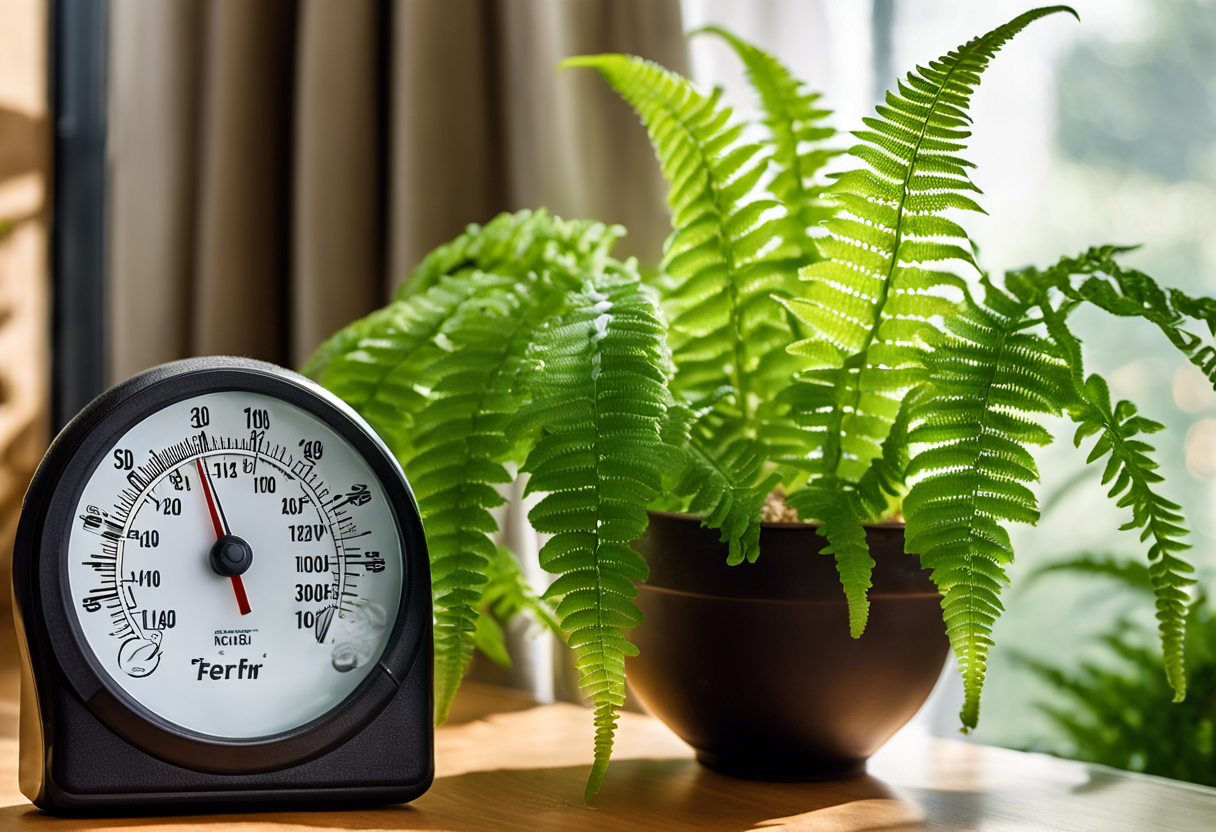Ever found yourself wondering just how much chill your beloved Kimberly Queen Fern Cold Tolerance could handle? Well, you’re not alone. I’ve been there too, staring at my fern on a frosty morning, sipping my hot chocolate and pondering the same.
Whether you’re a seasoned green thumb or a budding plant parent, understanding the cold tolerance of your plants is crucial. After all, we wouldn’t want our leafy friends catching a cold now, would we? So buckle up and keep reading about ‘How Cold Can Kimberly Queen Fern Take?’
Key Takeaways
- Kimberly Queen Ferns can withstand temperatures as low as 50°F (10°C).
- They are not frost-tolerant and will die if exposed to freezing temperatures.
- If the temperature drops below 50°F, it’s best to bring them indoors.
- They prefer warmer climates and thrive in temperatures between 70°F and 80°F.
- In colder regions, they should be grown as indoor plants or moved inside during winter.
: What is a Kimberly Queen Fern?
Well, let’s dive right in! The Kimberly Queen Fern is one of those fern varieties that’s a total showstopper. It’s a popular houseplant and a darling in the world of indoor gardening. With its lush, sword-like fronds and compact growth habit, it’s no wonder this ornamental plant has won the hearts of many green thumbs!
: Origin and General Characteristics
Now, where does this beauty hail from? The origin of Kimberly Queen Fern can be traced back to Australia. Yep, it’s an Australian native plant that loves tropical climates.
Its unique plant features include upright fronds that are more resistant to shedding than other ferns. This makes it less messy and ideal for indoor settings.
: Ideal Growing Conditions
So you’re probably wondering, “What does this Aussie beauty need to thrive?” Well, the growing conditions for ferns like the Kimberly Queen are quite specific but manageable.
First off, light requirements for Kimberly Queen Ferns are moderate indirect sunlight. Too much direct sun can scorch its lovely leaves.
Next up is soil type. The best soil for ferns is well-draining but retains some moisture – think peat moss or perlite mixtures.
And finally, watering needs. Watering ferns isn’t too complicated – keep the soil consistently moist but not waterlogged. Remember folks, these plants don’t like drying out!
How Does Temperature Affect Kimberly Queen Ferns?
Temperature plays a vital role in the life of any plant, including our beloved Kimberly Queen Ferns. It’s like the conductor of an orchestra, dictating when and how the plant’s biological processes should play out.
The Role of Temperature in Plant Growth
Now, let’s get down to the nitty-gritty. Temperature influences many aspects of plant growth. For instance, it affects photosynthesis rates – you know, that process where plants turn sunlight into food? Yeah, temperature is a big deal there.
Moreover, cellular functions within plants are also temperature-dependent. Think about it as if you’re baking a cake. Too hot or too cold and your masterpiece might not rise properly! Same goes for our green friends.
Specific Impact of Cold on Kimberly Queen Ferns
When we talk about Kimberly Queen Fern cold tolerance, things get a bit chilly. These ferns can handle temperatures as low as 50°F (10°C). Anything lower than that and they start to feel uncomfortable.
Frost damage is another concern for these beauties. Imagine being outside in freezing temperatures without a proper coat – not fun, right? That’s how your fern feels during frosty nights.
To protect them from Jack Frost’s icy touch, consider bringing them indoors or providing some form of cover during winter months. Remember folks, a warm fern is a happy fern!
What is the Lowest Temperature Kimberly Queen Fern Can Withstand?
When it comes to Kimberly Queen Fern cold tolerance, we’re talking about a pretty tough cookie. This fern can withstand temperatures as low as 20°F (-6°C). But remember, just because it can doesn’t mean it wants to.
Understanding Plant Hardiness Zones
So, let’s talk about plant hardiness zones. These are basically a map for gardeners, telling you what plants will survive in your local climate. It’s like a plant dating app – swipe right if you’re compatible!
Now, the USDA has this handy-dandy USDA plant hardiness zone map that breaks down the US into different climate zones for plants. Each zone represents a certain range of temperatures that a plant can handle.
Hardiness Zone for Kimberly Queen Fern
Alrighty then, let’s get back to our star: the Kimberly Queen Fern. According to the USDA, this fern is most comfortable in hardiness zones 9-11. That means it likes places where winter lows stay above 20°F (-6°C).
But don’t despair if you’re not living in these zones! With proper care and protection during colder months, your Kimberly Queen Fern can still thrive indoors or out. Just remember: she’s not a fan of frosty toes!
How to Protect Your Kimberly Queen Fern from Cold?
Protecting your Kimberly Queen Fern from cold is crucial for its survival. Whether you’re keeping it indoors or outdoors, there are specific strategies that can help maintain its health during the chilly months. Let’s dive into the world of Kimberly Queen Fern care and explore some effective cold weather plant protection methods.
Indoor Care During Winter
When winter hits, bringing your Kimberly Queen Fern indoors can be a game-changer. The key here is maintaining an optimal temperature for your fern. You don’t want it to feel like it’s in Antarctica, right? So, keep your home’s temperature above 60°F (16°C). That’s the sweet spot for this tropical beauty.
Now, controlling indoor temperature isn’t just about cranking up the heat. It also involves avoiding cold drafts. So, keep your fern away from drafty windows or doors. Remember, we’re aiming for a cozy winter vibe here, not a frostbite-inducing chill!
And let’s not forget humidity! These ferns love moisture. Consider using a humidifier or placing the pot on a tray filled with water and pebbles to maintain humidity levels. With these winter plant care tips, your Kimberly Queen Fern indoor survival is pretty much guaranteed!
Outdoor Protection Strategies
If you prefer keeping your Kimberly Queen Fern outdoors during winter, don’t fret! There are ways to protect it from the harsh cold too. First off, consider its location carefully. A sheltered spot under a patio or deck works wonders in shielding it from frost.
Covering plants in winter is another effective strategy to ensure their survival. Use breathable plant covers or old bed sheets to wrap around your fern when temperatures drop significantly at night.
Also remember that while these ferns are tough cookies, they aren’t fans of freezing temperatures. If forecasts predict a frosty night, bring your fern indoors if possible. With these outdoor fern protection strategies, your Kimberly Queen Fern can brave the cold and live to see another spring!
Signs Your Kimberly Queen Fern Has Been Affected by Cold
When your Kimberly Queen Fern has had a bit too much winter chill, it’ll show you. It’s like it’s saying, “Hey, I’m not a fan of this cold business!” Let’s chat about the telltale signs of cold damage and how to nurse your fern back to good plant health.
Physical Symptoms of Cold Damage
First off, your fern might start looking a bit under the weather. Literally! Cold exposure can cause some funky fern symptoms, like leaf discoloration or wilting. If you see your fern sporting a new shade of brown or its fronds are drooping like overcooked spaghetti, that’s a sign it’s feeling the freeze.
But wait, there’s more! In severe cases, you might even notice frost damage. That’s when the leaves look all shriveled up and crispy – not exactly the lush green look we’re going for!
Recovery Steps for Cold-Damaged Ferns
Alrighty then, let’s talk recovery. If your fern has been hit with the cold stick, don’t panic! There are steps you can take to help it bounce back. First things first: move your plant to a warmer spot ASAP. This is an immediate action that can help stop further damage.
Next up in our fern recovery plan is hydration. Watering your plant properly can help it recover from cold damage. But remember folks – moderation is key! Overwatering can lead to other problems (and we don’t want that!).
Long-term care strategies include keeping an eye on temperature control and providing plenty of indirect light. And remember: patience is key when reviving ferns after cold damage. It may take some time for your Kimberly Queen Fern to get back its mojo but hang in there – with proper care and love, it’ll be back to its regal self in no time!
To Wrap Up
Just like a toddler wrapped in the coziest winter onesie, your Kimberly Queen Fern can handle a bit of chill. But remember, she’s no polar bear! If you’re still unsure about the limits of Kimberly Queen Fern Cold Tolerance, do some extra research.
In the end, it’s all about giving your green lady what she needs to thrive. So let’s keep our ferns fabulous, even when Jack Frost is knocking at the door!



